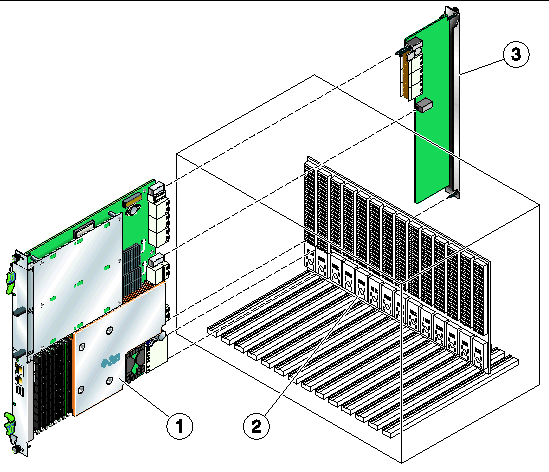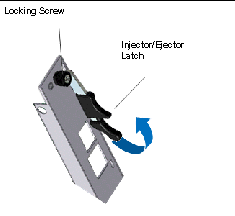| C H A P T E R 2 |
|
Installing and Removing the ARTM-FC |
This chapter contains procedures for unpacking, installing, and removing the Sun Netra CP32x0 Quad GbE, Dual-Fibre Channel, Advanced Rear Transition Module (ARTM-FC).
This chapter contains the following sections:
Before installing the Sun Netra CP32x0 ARTM-FC, verify the ARTM’s part number to ensure that the correct ARTM is being installed into the system. For information on identifying the ARTM, see Section 1.5, Part Number, Serial Number, and MAC Address Labels.
The following paragraphs provide important information to ensure compatibility and safety of the ARTMs, other components, and the system.

|
Caution - When a system is plugged in, energy hazards are present on the midplane. Do not reach into the enclosure. |

|
Caution - Electrostatic discharge (ESD) can damage electronic components. Use an antistatic wrist strap and a conductive foam pad when installing or upgrading any components. |
After removing the component from its protective wrapper or from the system, place the component flat on a grounded, static-free surface (and, in the case of a board, component side up). Do not slide the component over any surface.
If an ESD station is not available, you can avoid damage resulting from ESD by wearing an antistatic wrist strap (available at electronics stores) that is attached to an active electrical ground. Note that a system chassis might not be grounded if it is unplugged.

|
Caution - Dangerous voltages, capable of causing death, are present in this equipment. Use extreme caution when handling, testing, and adjusting equipment. |
If the shipping carton is damaged upon receipt, request that the carrier’s agent be present during the unpacking and inspection of the equipment.
1. Unpack the equipment from the shipping carton.
2. Refer to the packing list and verify that all items are present.
3. Save the packing material for storing and reshipping of equipment.
4. Avoid touching areas of integrated circuitry.
Static discharge can damage circuits.
5. After removing the product from the packaging, check for any obvious physical damage.
6. Disconnect the chassis from the main power supply before you install the ARTM.
The Sun Netra CP32x0 ARTM-FC can be installed into an ATCA shelf (chassis) with a midplane made for front- and rear-board installations. The ARTM must be installed in the slot directly behind the host ATCA node board. These back-to-back slots have common PINs to enable passing of signals via the Zone 3 connector complex.
The Sun Netra CP32x0 ARTM-FC is designed to comply with UL60950-1, and is intended to be used with similarly tested AdvancedTCA products that have user documentation detailing installation of AMC module accessories.
Be sure to validate that the chassis and the ARTM slot is cable of providing the ARTM the maximum power requirements of 25W current draw.
The Sun Netra CP32x0 ARTM-FC was tested and qualified to operate with the following Sun Netra ATCA host boards:
The Sun Netra CP32x0 ARTM-FC is designed to operate with similarly tested AdvancedTCA products.
ARTMs can be damaged when improperly handled. Read and follow the guidelines in this section to protect your equipment.
Installation persons are urged to use an antistatic wrist strap and a conductive foam pad when installing or upgrading a system. See Section 2.1.1, Take Antistatic Precautions.
Bent PINs or loose components can cause damage to the ARTM, host board, the backplane, or other system components. Carefully inspect your ARTM and the backplane for both PIN and component integrity before installation. Our manufacturers take significant steps to ensure there are no bent PINs on the backplane or connector damage to the products prior to leaving our factory. Bent PINs caused by improper installation or by products with damaged connectors could void the warranty for the backplane, boards, and modules.
If a system contains one or more crushed PINs, power off the system and contact your local sales representative to schedule delivery of a replacement chassis assembly.
To preserve compliance with applicable standards and regulations for electromagnetic interference (EMI), during operation all front and rear openings on the chassis or board faceplates must be filled with an appropriate card or covered with a filler panel. If the EMI barrier is open, devices might cause or be susceptible to excessive interference.
Your ARTM-FC is electrically designed for hot-swap insertion within a fully powered chassis. However, hot-swap removal is not supported.

|
Caution - Powering down or removing a board before the operating system or other software running on the board has been properly shut down can cause corruption of data or file systems. |
Prior to board removal, terminate applications or operating systems running on the board. When this task is complete, use the shelf manager to manually shut down (activate/deactivate) the ATCA board, which in turn shuts down the ARTM-FC.
There is a blue LED on the rear faceplate. This LED is under software control and indicates the following:
|
Module state is indeterminate, and the module should not be removed. |
Hot-swap compliant components may be installed while the system is powered on. If a module is not hot-swap compliant, remove power to the slot or system before installing the component.
Prevent possible damage to components by verifying the proper slot usage for your configuration. See Section 2.1.3, Use a Compatible Chassis and Slot.
In most cases, electronic keying (e-Keying) will prevent a module to power on in an incompatible slot. However, as an extra precaution, you should be familiar with the slot purpose.
This section describes the procedure for installing the ARTM-FC in a chassis. See FIGURE 2-1 for an example of installing a node board and ARTM-FC into a chassis.
Before you install your ARTM-FC, read all cautions, warnings, and instructions presented in the following sections:
FIGURE 2-1 Installing a Node Board and ARTM-FC Into the ATCA Chassis

The Sun Netra CP32x0 ARTM-FC must be used with a Netra ATCA node board for rear I/O access. The ARTM-FC enables access to Fibre Channel networks and additional GbE connections.

|
Caution - Ensure that no node board is installed in front of the rear midplane slot. This precaution is very important if you are installing into a powered midplane. |
|
1. Verify that you have taken the necessary antistatic precautions.
2. Facing the back of the system, identify an appropriate slot for the ARTM-FC.
ARTM-FCs must be installed inline behind the accompanying node board. If the accompanying node board is to be installed in slot 3, its ARTM-FC must be installed at the back of the system in slot 3.
3. Remove the slot filler panel from the selected node board slot, if necessary.
4. Prepare the module by loosening the locking screws and opening the injector/ejector latch at the top of the module.
FIGURE 2-2 Injector/Ejector Latch and Locking Screw

5. Carefully align the edges of the module with the guides in the appropriate slot.
It might be helpful to look into the enclosure to verify correct alignment of the rails in the guides.
6. Taking care to keep the module aligned in the guides, slide the module in until the injector/ejector mechanism engages the retention bars.
7. Simultaneously push in the module and rotate the injector/ejector mechanism inward to its closed position to seat the midplane connectors.
8. Tighten the module retention screws to ensure that the module is secured into the shelf.
9. Install the node board into the front of the shelf (FIGURE 2-1) and push the board toward the midplane. Ensure that it is seated properly and that the connectors make good contact with the ARTM-FC.
For further details on installation of the board, refer to the appropriate user documentation for the board.
10. Install the supported peripheral at the ARTM-FC’s connector ports, as required.
Use shielded cables for the ports on the ARTM-FC. The shield should be grounded at both ends. For further details on installation of the board, refer to the appropriate user documentation for the board.
11. Power on the system, if necessary.
Refer to your system manual for instructions on correctly powering on the system.

|
Caution - Payload Power to the Sun Netra CP32x0 ARTM-FC must be off before the module can be safely removed. |
|
1. Deactivate the ARTM-FC from the shelf manager, or manually deactivate the ARTM-FC by unlatching the top latch and waiting for the blue LED to light steady.
For example, to deactivate just the ARTM-FC in slot 1, log into the shelf manager and type:
where “9a” is the hex address for slot 1, and ‘3’ is the ARTM-FC in slot 1.
Alternatively, to deactivate both the ARTM-FC and its companion node board, type:
2. Loosen the locking screws on the ARTM-FC.
3. Pull the ARTM-FC out of the card slot.
4. If the card slot is to remain empty, install a filler panel in the slot.
5. Reactivate the node board, if necessary.
The color of the Out-of-service (OOS) LED can be set to red or amber by moving jumper E21 to the appropriate position. Setting the jumper to the 1-2 position makes the OOS LED appear red (default setting). Setting the jumper to the 2-3 position makes the OOS LED appear amber.
Copyright © 2009 Sun Microsystems, Inc. All rights reserved.